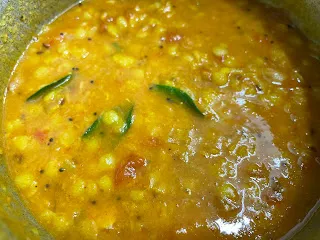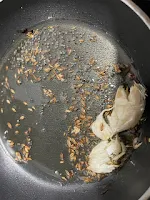Tomato Dal recipe | Redgram Dal with Tomato | Pigeon Pea dal with Tomato | Healthy dal curry with Tomato | Tomato Gungo Peas dal | Indian Tomato Dal | Easy Tomato Dal recipe | Spicy Tomato Dal | South Indian Tomato Dal | Tomato and Toor Dal recipe
"Redgram and Tomato Curry: A Hearty and Tangy Delight"
Recipe: Redgram and Tomato Curry
- Preparation Time: 15 minutes
- Cooking Time: 25 minutes
- Total Time: 40 minutes
- Servings: 4
1. Introduction:
Red gram and Tomato Curry
is a comforting and nutritious dish rooted in Indian cuisine. This hearty curry
combines the wholesome goodness of Red gram (Pigeon Peas) with the tanginess of
tomatoes, spiced with aromatic seasonings. It's a versatile dish that can be
enjoyed with rice, chapati, or pulka, making it suitable for both everyday
meals and special occasions.
2. Importance
of Ingredients:
- Red gram (Pigeon Peas): Rich
in protein, fiber, and essential nutrients, Red gram is known for its health
benefits including improved digestion and sustained energy levels.
- Tomatoes: Packed
with vitamins, minerals, and antioxidants, tomatoes contribute to heart health,
skin health, and overall well-being.
- Tamarind: Adds
a tangy flavor and aids digestion, providing a unique taste to the curry.
- Spices (Mustard Seeds,
Cumin Seeds, Turmeric, Chilli Powder): Enhance flavor and
offer anti-inflammatory properties.
3. Occasions
and who can enjoy it:
Red gram and Tomato Curry
is suitable for various occasions:
- Daily Meals: A
staple in many Indian households, enjoyed for lunch or dinner.
- Celebrations: Serve
it at festive gatherings paired with other traditional dishes.
- Family Gatherings: Its
comforting flavors appeal to all age groups, making it a family favorite.
4. Benefits
and Uses of Having This Recipe:
- Nutritious Meal: Provides
essential proteins, fibers, and vitamins necessary for a balanced diet.
- Versatile: Can
be served with rice, chapati, or pulka, accommodating different dietary
preferences.
- Easy Preparation: Cooks
quickly in a pressure cooker, ideal for busy schedules.
- Health Benefits: Supports
digestion, boosts immunity, and promotes overall well-being.
5. Ingredients:
- 2
cups Red gram (Pigeon Peas / Gungo Peas)
- 3
Tomatoes
- 1
Onion
- 1
tablespoon Mustard Seeds
- 1
tablespoon Cumin Seeds
- 2
Garlic Cloves, minced
- 2
tablespoons Oil
- 1
teaspoon Turmeric Powder
- Salt,
to taste
- 2
teaspoons Chilli Powder (adjust according to spice preference)
- 10
grams Tamarind (about a lime-sized ball)
- A
few Curry Leaves
- 5
cups Water
- Fresh
Coriander Leaves, chopped (for garnish)
6. Detailed
Cooking Instructions:
1. Prepare
the Tamarind:
- Start by
soaking the tamarind in 1 cup of warm water. Let it sit while you prepare the
rest of the ingredients.
2. Prepare
the Ingredients:
- Rinse the
Red gram (Pigeon Peas) thoroughly under running water. Drain and set aside.
- Wash the
tomatoes and chop them into small pieces.
- Peel and
chop the onion.
3. Cook
the Red gram and Tomatoes:
- In a
pressure cooker, combine the washed Red gram, chopped tomatoes, and onion.
- Add 4 cups
of water to the cooker. Close the lid and cook on high heat.
- After the cooker
whistles 3 times, turn off the heat and allow the pressure to release
naturally. Once safe, open the cooker and set it aside to cool.
4. Prepare
the Seasoning (Tadka):
- In a small
frying pan (tadka pan), heat 2 tablespoons of oil over medium heat.
- Add mustard
seeds and cumin seeds. Allow them to splutter.
- Add minced
garlic and sauté until it turns golden brown and fragrant.
5. Combine
and Season the Dal:
- Once the
pressure cooker has cooled down, open it carefully.
- Place the
cooker back on medium heat. Stir in salt, turmeric powder, and chilli powder
(adjust according to your spice tolerance).
- Mix well and
let it simmer for a few minutes to blend the flavors.
6. Add
the Seasoning (Tadka):
- Pour the
prepared seasoning (tadka) into the dal mixture in the pressure cooker.
- Stir to
combine, allowing the flavors to meld together.
7. Add
Tamarind Extract:
- Squeeze the
soaked tamarind to extract the pulp and discard any solids.
- Add the tamarind
extract to the dal mixture. Stir well to incorporate.
8. Final
Cooking and Garnish:
- Let the dal
curry simmer until it reaches the desired consistency. If it thickens too much,
you can add a little hot water to adjust.
- Just before
removing from heat, add ahandful of washed and chopped fresh coriander leaves.
Stir to combine.
9. Serving:
- Serve the
Redgram and Tomato Curry hot, garnished with additional coriander leaves if
desired.
- It pairs
well with steamed rice, chapti, or pulka.
7. Storage:
- Store any leftover curry
in an airtight container in the refrigerator for up to 2 days. Reheat gently
before serving.
8. Health
Benefits and Uses:
- Digestive Health: Tamarind
aids digestion and helps alleviate digestive issues.
- Nutrient-Rich: Provides
essential nutrients like protein, fiber, and vitamins.
- Heart Health: Tomatoes
contribute to heart health and may help lower cholesterol levels.
1. Red gram (Pigeon
Peas/Gungo Peas):
- Rich in Protein: Red
gram is an excellent source of plant-based protein, essential, essential for
muscle repair and growth.
- High in Fiber: Fiber
aids digestions, prevents constipation, and promotes a healthy gut.
- Low Glycemic Index: Helps
in maintaining stable blood sugar levels, making it suitable for diabetics.
- Nutrients-Dense: Contains
vitamins (like folate, vitamin B6) and minerals (iron, potassium) beneficial
for overall health.
2. Tomatoes:
- Rich in Antioxidants: Tomatoes
are packed with antioxidants such as lycopene, which may reduce the risk of
chronic diseases and protect against oxidative stress.
- Heart Health: The
potassium and vitamin C in tomatoes support heart health by regulating blood
pressure and reducing cholesterol levels.
- Skin Health: Vitamin
C and lycopene contribute to skin health, protecting against UV damage and
promoting collagen production.
- Cancer Prevention: Lycopene
has been associated with a reduced risk of certain cancers, including prostate
cancer.
3. Tamarind:
- Digestive Aid: Tamarind
contains fiber and natural laxatives that aid digestion, relieve constipation,
and promote regular bowel movements.
- Anti-inflammatory: Compounds
in tamarind possess anti-inflammatory properties, potentially reducing
inflammation in the body.
- Antioxidant Properties: Helps
combat oxidative stress due to its rich antioxidant content.
4. Spices (Mustard Seeds,
Cumin Seeds, Turmeric, Chilli Powder):
- Anti-inflammatory: Turmeric
contains curcumin, known for its anti-inflammatory and antioxidant properties.
- Digestive Health: Cumin
seeds aid digestion, reduce bloating, and may improve nutrient absorption.
- Metabolism Boost: Mustard
seeds can stimulate metabolism and aid in weight management.
- Capsaicin Benefits: Chilli
powder contains capsaicin, which may boost metabolism, reduce appetite, and aid
in weight loss.
9. Uses and Benefits of
Red gram and Tomato Curry:
- Nutrient-Rich Meal: Provides
a balanced combination of protein, fiber, vitamins, and minerals essential for
overall health.
- Weight Management: High
fiber and protein content promote satiety and may aid in weight loss or weight
maintenance.
- Digestive Support: Ingredients
like tamarind and cumin seeds support digestive health, alleviate bloating, and
promote regularity.
- Heart Health: The
combination of ingredients supports heart health by reducing cholesterol levels
and regulating blood pressure.
10. Cooking
Tips and Variations:
- Adjust Spice Levels: Customize
chilli powder according to preference.
- Consistency: Adjust
water to achieve desired thickness.
- Vegetarian Variation: Replace
oil with ghee for added flavor.
- Garnish: Experiment
with fresh mint leaves or grated coconut for a twist.
- Adjust the spiciness of
the curry by varying the amount of chilli powder.
- Ensure the tamarind pulp
is well strained to avoid any fibrous textures in the curry.
- You can also add a pinch
of asafetida (hinge) during the tadka process for added flavor.
- To maximize the health
benefits, avoid overcooking vegetables and pulses to retain their nutrient
content.
- Experiment with different
levels of spices and herbs to suit your taste preferences and dietary needs.
- Incorporate fresh
ingredients and whole spices for enhances flavor and nutritional value.
Incorporating Red gram and
Tomato Curry into your diet provides a flavorful and nutritious option that
supports overall health, digestive function, and may contribute to long-term
well-being.
11. Nutritional
Information (per serving):
- Red gram (Pigeon Peas)
are rich in protein and fiber, making this curry not only delicious but also
nutritious.
- Tomatoes provide vitamins
and antioxidants, enhancing the health benefits of this dish.
- Calories: 250 kcal
- Protein: 15g
- Fat: 8g
- Carbohydrates: 35g
- Fiber: 12g
Enjoy this hearty and
flavorful Red gram and Tomato Curry as a wholesome meal option!
12. Presentation
and Servings:
- Serve Red gram and Tomato
Curry hot, garnished with fresh coriander leaves.
- Pair with steamed rice,
chapati, or pulka for a complete meal experience.
Conclusion:
Red gram and Tomato Curry is a wholesome dish that combines
nutritious ingredients with aromatic spices. Its versatility makes it suitable
for various occasions and appealing to all age groups. Enjoy this flavorful
curry as a nutritious addition to your meal repertoire, providing essential
nutrients and promoting overall well-being.






Comments
Post a Comment